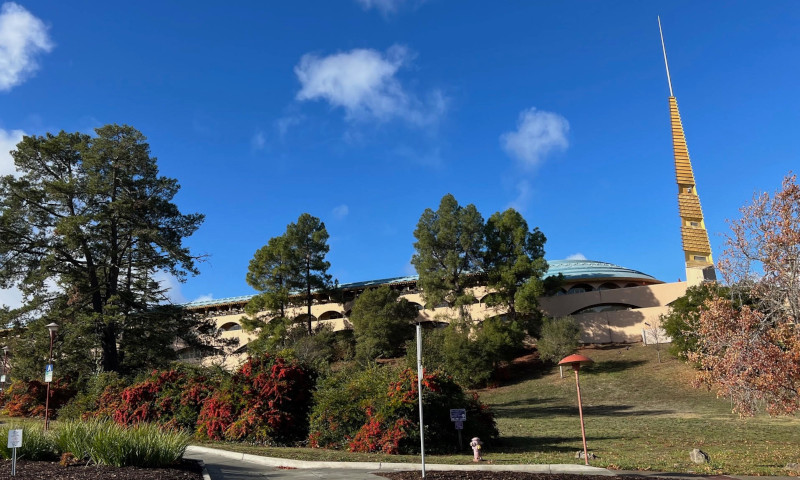AplosGroup couldn’t let the year pass without a celebratory note marking a special anniversary. 2022 is the 60th anniversary of Frank Lloyd Wright’s iconic Marin County Civic Center. This amazing building is said to be the only government complex he ever designed, and it proved to be his final major undertaking. The planning and design took place in 1957 to 1958. The civic center building was actually built in two stages, after Wright’s death. The complex’s history took a long and winding path before it reached a successful conclusion.
According to the Society of Architectural Historians:
“The Marin County Planning Commission sponsored a study of the county’s space needs in 1952. The following year the county’s Board of Supervisors appointed a committee to select a site that would not only provide space for government functions but also for a county fairground. In 1956 the county purchased the 140-acre Scettrini family ranch and interviewed numerous architects.”
Wright had refused to participate in a competition. Would he consider the project now?
Two strong women, dissatisfied with the results of the 26 architectural firms interviewed, took a bold step. They wanted the best. So, they reached out to Aaron Green, a protégé of Frank Lloyd Wright, to see if he might be interested. It would be easy to say the rest is history, but as I intimated, it was not a straight path to success.
Vera Shultz, a Marin County Supervisor, and Mary Summers, Planning Director, led the effort to engage Wright to design the Civic Center complex, Lagoon Park, and the federal post office.
In 1957, some members of the Planning Commission met with Wright in Berkeley, where he’d come to lecture at the Unniversity of California. He returned about three months later to visit the site in San Rafael. He was offered the commission. A standout element of Wright’s work was his ability to highlight and honor the surrounding environment of his projects. One beautiful example, in a residential design, is his Fallingwater, completed in 1935, in Pennsylvania. Built on Bear Run, partly over a waterfall, the home’s varying levels and outcropping reflect the surrounding landscape.
Once he saw the gentle hills of the proposed Marin site, he is quoted as saying:
“A good building is not one that hurts the landscape but is one that makes the landscape more beautiful than it was before the building was built. In Marin County you have one of the most beautiful landscapes I have ever seen, and I am proud to make the buildings of the county characteristic of the beauty of the county.”
However grand Wright’s vision, one conservative supervisor, William Fusselman, opposed Wright’s commission. He enlisted the aid of Wisconsin Republican State Assemblyman Carroll Metzner, a staunch opponent of Wright in Wisconsin. He accused Wright of being a Communist, among other things.
Eerily reminiscent of today’s political trash-talking, Fusselman and Metzner were guests on a radio program denouncing Wright’s design philosophy as socialist.
Inherent in that criticism might have been Wright’s underlying intentions with the design. The landscape always played a key role in his work, but the Civic Center went beyond that. As a government building, Wright didn’t hide his desire to show that by placing the public library (integral to his design) above the county supervisors chambers, he was placing knowledge over a seat of power. A not so gentle reminder that the real power rests with an informed public. A concept we continue to grapple with today.
Wright’s design and philosophy rankled Fusselman. However, Vera Shultz refused to be defeated. She remained a staunch champion of Wright and worked to gather support for his commission. The opponents wanted a referendum on Wright’s design. In addition to his opposition to Wright, Fusselman did not like the fact that the seat of government would be moving from downtown San Rafael to Santa Venetia. He opposed so much change.
He and the opponents failed, and eventually the board approved Wright’s commission. In April 1958 Wright was asked to proceed with a detailed design. In March 1959, Wright received the appointment to design the post office on the corner of North San Pedro Road and what would become Civic Center Drive. Wright died on April 9, 1959, at the age of 91. The groundbreaking for the Civic Center Administration Building took place on February 15, 1960.
Wright’s Final Project is Stopped January 1961
As often happens in elections, the composition of the Marin County Board changed in June 1960. The following January, the board voted to halt the work on the Civic Center. They considered changing the project to one of building a hospital, instead.
Stultz’s outspoken support and the power of the press came to the rescue. A poll of Marin residents by the Marin IJ showed overwhelming support for the Civic Center project and the stop-work order was lifted.
The Civic Center Administration Building, with the guidance of Aaron Green, was completed in 1962. According to records, the Hall of Justice began in1966 and was completed in 1969. Next came the Veterans Memorial Auditorium in 1971 and the Exhibit Hall in 1976.
The building is now a registered historical landmark and docent-led tours are available to the public. Discover for yourself the beautiful design aspects of Wright’s work. The building is a popular tourist attraction for lovers of architectural vision. Schedule a tour today!


